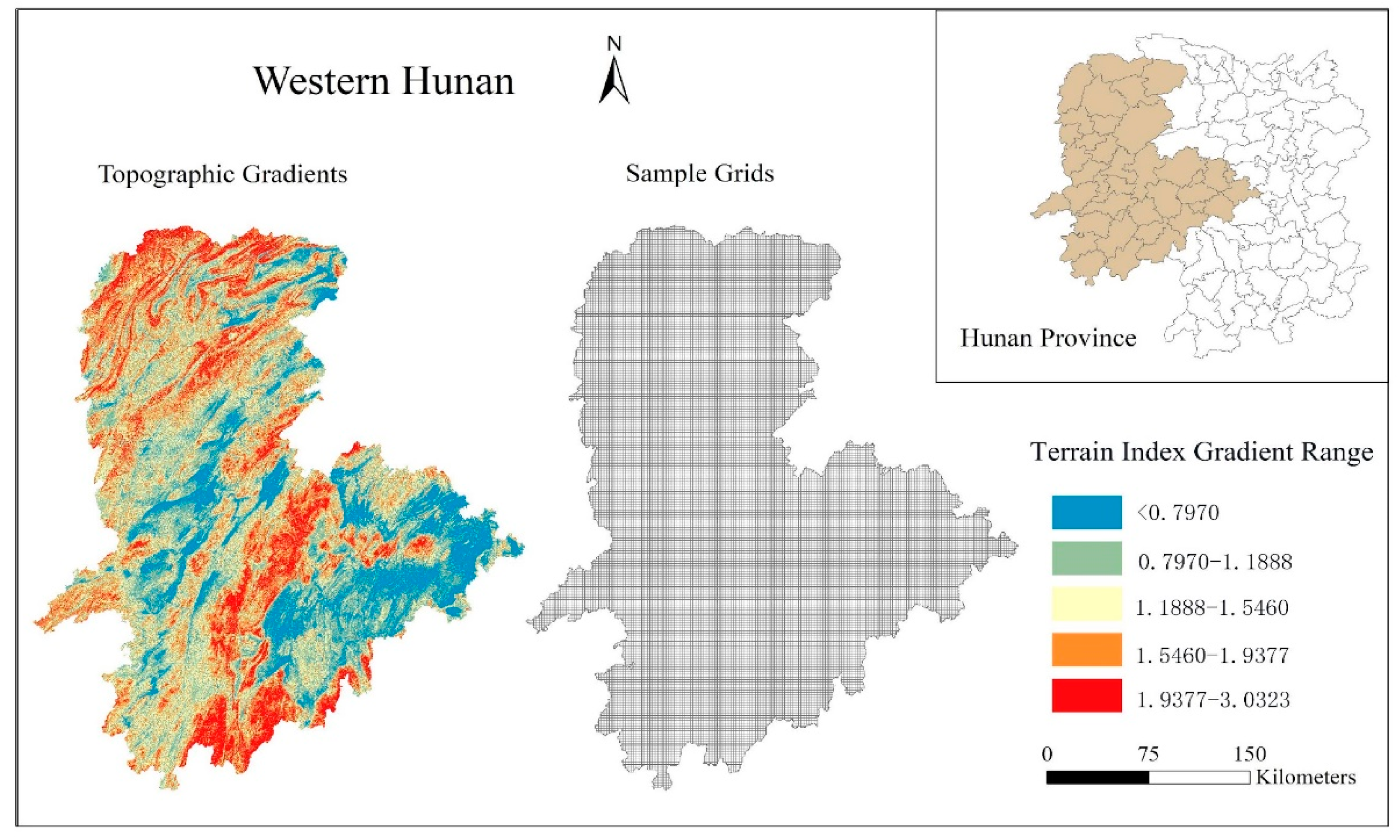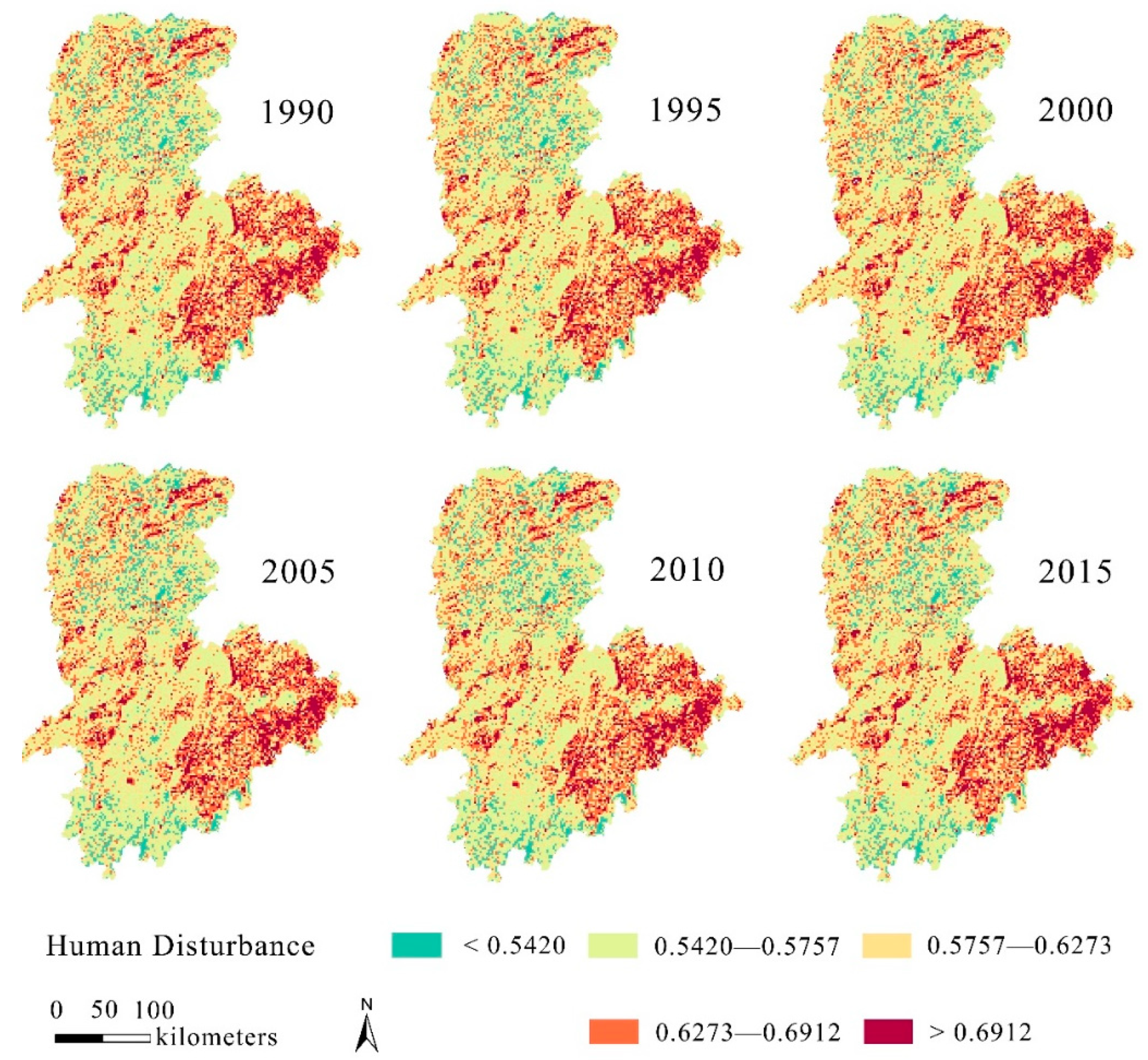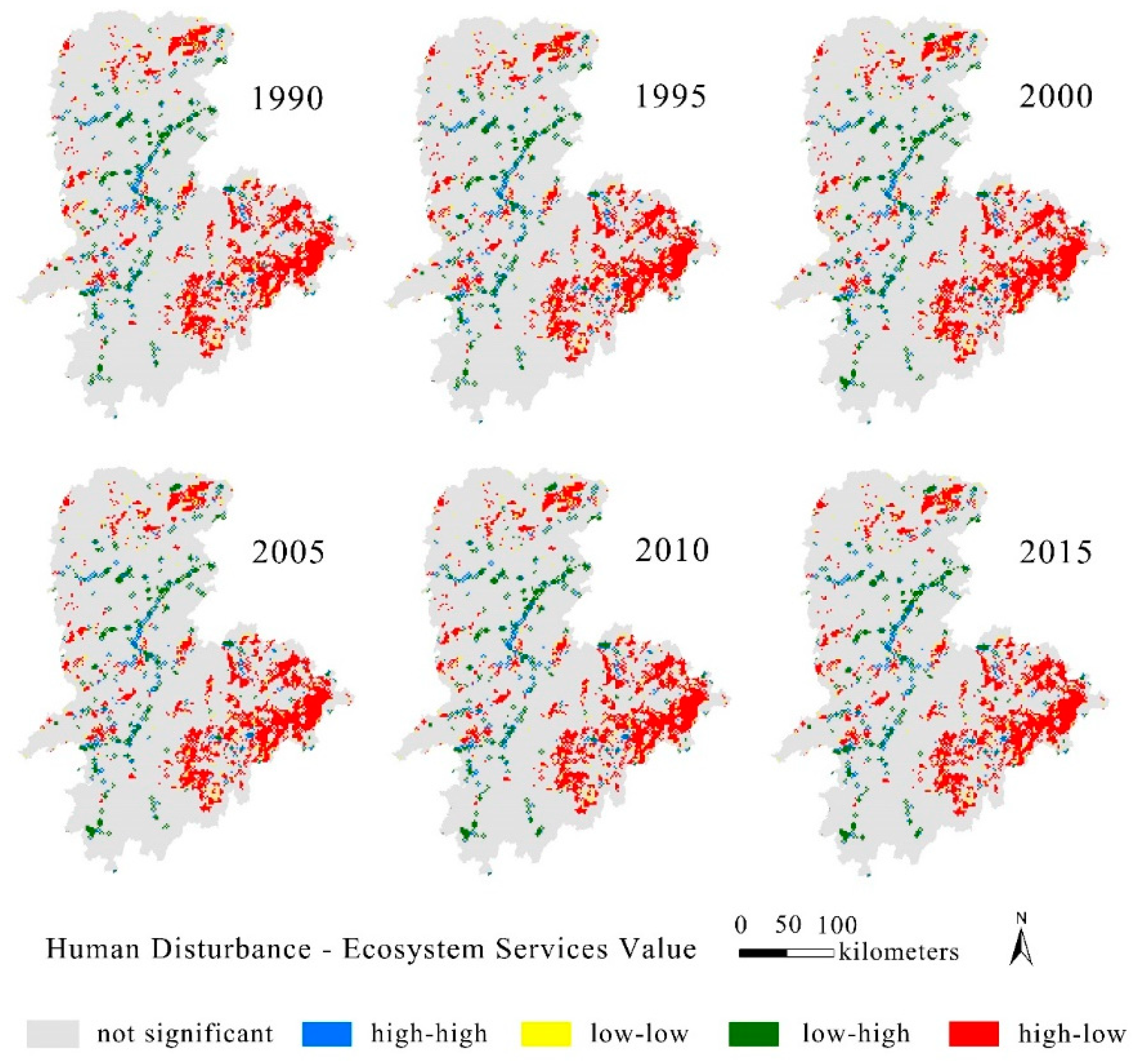Ecosystem Service Response to Human Disturbance in the Yangtze River Economic Belt: A Case of Western Hunan, China
Abstract
:1. Introduction
2. Materials and Methods
2.1. Study Area
2.2. Data Collection
2.3. Method
2.3.1. Topographic Factors Grading
2.3.2. Ecosystem Service Value Evaluation
2.3.3. Human Disturbance Evaluation
2.3.4. Spatial Correlation Analysis
3. Results
3.1. Land-Use Changes at Different Topographic Gradients
3.2. Temporal and Spatial Changes of the Ecosystem Service Value at Topographic Gradients
3.3. The Spatial Distribution of Human Disturbance
3.4. Spatial Relationship between ESV and Human Disturbance
4. Discussion
4.1. The Influence of Land-Use Patterns on ESV in Different Terrain Gradients
4.2. Effects of Human Disturbance on ESV in Different Terrain Gradients
5. Conclusions
Author Contributions
Funding
Acknowledgments
Conflicts of Interest
References
- Millennium Ecosystem Assessment (MA). Ecosystems and Human Well-being: Synthesis; Island Press: Washington, DC, USA, 2015. [Google Scholar]
- Daily, G.C.; Polasky, S.; Goldstein, J.; Kareiva, P.M.; Mooney, H.A.; Pejchar, L.; Ricketts, T.H.; Salzman, J.; Shallenberger, R. Ecosystem services in decision making: Time to deliver. Front. Ecol. Environ. 2009, 7, 21–28. [Google Scholar] [CrossRef] [Green Version]
- Walz, U.; Stein, C. Indicators of hemeroby for the monitoring of landscapes in Germany. J. Nat. Conserv. 2014, 22, 279–289. [Google Scholar] [CrossRef]
- Zhou, Y.; Ning, L.; Bai, X. Spatial and temporal changes of human disturbances and their effects on landscape patterns in the Jiangsu coastal zone, China. Ecol. Indic. 2018, 93, 111–122. [Google Scholar] [CrossRef]
- Vallecillo, S.; Polce, C.; Barbosaa, A.; Castilloc, C.P.; Vandecasteelec, I.; Ruschd, G.M.; Maesa, J. Spatial alternatives for Green Infrastructure planning across the EU: An ecosystem service perspective. Landsc. Urban. Plan. 2018, 174, 41–54. [Google Scholar] [CrossRef]
- Cimon-Morin, J.; Darveau, M.; Poulin, M. Fostering synergies between ecosystem services and biodiversity in conservation planning: A review. Biol. Conserv. 2013, 166, 144–154. [Google Scholar] [CrossRef]
- Huang, Y.; Yin, X.; Ye, G.; Lin, J.; Huang, R.; Wang, N.; Wang, L.; Sun, Y. Spatio-temporal Variation of Landscape Heterogeneity under Influence of Human Activities in Xiamen City of China in Recent Decade. Chin. Geogra. Sci. 2013, 23, 227–236. [Google Scholar] [CrossRef]
- Brentrup, F.; Küsters, J.; Lammel, J.; Kuhlmann, H. Life cycle impact assessment of land use based on the hemeroby concept. Int. J. Life Cycle Assess. 2002, 7, 339–348. [Google Scholar]
- Fehrenbach, H.; Grahl, B.; Giegrich, J.; Busch, M. Hemeroby as an impact category indicator for the integration of land use into life cycle (impact) assessment. Int. J. Life Cycle Assess. 2015, 20, 1511–1527. [Google Scholar] [CrossRef]
- Cannon, S.E.; Donner, S.D.; Fenner, D.; Beger, M. The relationship between macroalgae taxa and human disturbance on central Pacific coral reefs. Mar. Pollut. Bull. 2019, 145, 161–173. [Google Scholar] [CrossRef]
- Johnson, C.J.; Russell, D.E. Long-term distribution response of a migratory caribou herd to human disturbance. Biol. Conserv. 2014, 177, 52–63. [Google Scholar] [CrossRef]
- Plante, S.; Dussault, C.; Richard, J.H.; Côté, S.D. Huma disturbance effects and cumulative habitat loss in endangered migratory caribou. Biol. Conserv. 2018, 224, 129–143. [Google Scholar] [CrossRef]
- Setsaas, T.; Hunninck, L.; Jackson, C.R.; May, R.; Røskaft, E. The impacts of human disturbances on the behavior and population structure of impala (Aepyceros melampus) in the Serengeti ecosystem, Tanzania. Glob. Ecol. Conserv. 2018, 16, e00467. [Google Scholar] [CrossRef]
- Liu, H.; Gao, C.; Wang, G. Understand the resilience and regime shift of the wetland ecosystem after human disturbances. Sci. Total. Environ. 2018, 643, 1031–1040. [Google Scholar] [CrossRef] [PubMed]
- Delgado- Fernandez, I.; O’Keeffe, N.; Davidson-Arnott, R.G.D. Natural and human controls on dune vegetation cover and disturbance. Sci. Total. Environ. 2019, 672, 643–656. [Google Scholar] [CrossRef]
- Dainese, M.; Aikio, S.; Hulme, P.E.; Bertolli, A.; Prosser, F.; Marini, L. Human disturbance and upward expansion of plants in a warming climate. Nat. Clim. Chang. 2017, 7, 577–582. [Google Scholar] [CrossRef]
- Rito, K.F.; Arroyo-Rodríguez, V.; Queiroz, R.; Leal, I.; Tabarelli, M. Precipitation mediates the effect of human disturbance on the Brazilian Caatinga vegetation. J. Ecol. 2017, 105, 1–11. [Google Scholar] [CrossRef] [Green Version]
- Chhetri, P.K.; Shrestha, K.B.; Cairns, D.M. Topography and human disturbances are major controlling factors in treeline pattern at Barun and Manang area in the Nepal Himalaya. J. Mt. Sci-Engl. 2017, 14, 119–127. [Google Scholar] [CrossRef]
- Vitousek, P.M.; Mooney, H.A.; Lubchenco, J.; Melillo, J.M. Human domination of earth’s ecosystems. Science 1997, 277, 494–499. [Google Scholar] [CrossRef] [Green Version]
- Li, H.; Man, W.; Li, X.; Ren, C.; Wang, Z.; Li, L.; Jia, M.; Mao, D. Remote sensing investigation of anthropogenic land cover expansion in the low elevation coastal zone of Liaoning Province, China. Ocean Coast. Manag. 2017, 148, 245–259. [Google Scholar] [CrossRef]
- Caplat, P.; Lepart, J.; Marty, P. Landscape patterns and agriculture: Modeling the long–term effects of human practices on Pinus sylvestris spatial dynamics (Causse Mejean, France). Landsc. Ecol. 2006, 21, 657–670. [Google Scholar] [CrossRef]
- Tasser, E.; Sternbach, E.; Taaeinei, U. Biodiversity indicators for sustainability monitoring at municipality level: An example of implementation in an alpine region. Ecol. Indic. 2008, 8, 204–223. [Google Scholar] [CrossRef]
- Günlü, A.; Kadioğullari, A.I.; Keleş, S.; Başkent, E.Z. Spatiotemporal changes of landscape pattern in response to deforestation in Northeastern Turkey: A case study in Rize. Environ. Monit. Assess. 2009, 148, 127–137. [Google Scholar] [CrossRef] [PubMed]
- Sun, Y.; Zhao, D.; Wu, T.; Wei, B.; Gao, S.; Li, Y.; Cao, F. Temporal and spatial dynamic changes and landscape pattern response of Hemeroby in Dayang estuary of Liaoning Province, China. Acta Ecol. Sin. 2012, 32, 3645–3655. [Google Scholar]
- Diwediga, B.; Wala, K.; Folega, F.; Dourma, M.; Woegan, Y.A.; Akpagana, K.; Le, Q.B. Biophysical and anthropogenous determinants of landscape patterns and degradation of plant communities in Mo hilly basin (Togo). Ecol. Eng. 2015, 85, 132–143. [Google Scholar] [CrossRef]
- Li, H.; Peng, J.; Liu, Y.; Hu, Y. Urbanization impact on landscape patterns in Beijing City, China: A spatial heterogeneity perspective. Ecol. Indic. 2017, 82, 50–60. [Google Scholar] [CrossRef]
- Chapin, F.S.; Zavaleta, E.S.; Eviner, V.T.; Naylor, R.L.; Vitousek, P.M.; Reynolds, H.L.; Hooper, D.U.; Lavorel, S.; Sala, O.E.; Hobbie, S.E.; et al. Consequences of changing biodiversity. Nature 2000, 405, 234–242. [Google Scholar] [CrossRef]
- Dias, D.M.; Massara, R.L.; Campos, C.B.; Rodrigues, F.H.G. Human activities influence the occupancy probability of mammalian carnivores in the Brazilian Caatinga. Biotropica 2019, 51, 1–13. [Google Scholar] [CrossRef]
- Cardelús, C.L.; Woods, C.L.; Bitew Mekonnen, A.; Dexter, S.; Scull, P.; Tsegay, B.A. Human disturbance impacts the integrity of sacred church forests, Ethiopia. PLoS ONE 2019, 14, 1–14. [Google Scholar] [CrossRef] [Green Version]
- Cai, Y.; Zhang, Y.; Hua, Z.; Deng, J.; Qin, B.; Yin, H.; Wang, X.; Gong, Z.; Heinoc, J. Metacommunity ecology meets bioassessment: Assessing spatio-temporal variation in multiple facets of macroinvertebrate diversity in human-influenced large lakes. Ecol. Indic. 2018, 103, 713–721. [Google Scholar] [CrossRef]
- Wu, J.; Liu, C.; Li, Y. Ecosystem services value Change and its response to human disturbance in the three gorges reservoir area (Chongqing section). Res. Soil Water Conserv. 2018, 25, 334–341. [Google Scholar]
- Xu, N.; Sun, S.; Xue, D.; Guo, L. Ecosystem service value and its spatial response to human interference on the basis of terrain gradient in Gannan region, China. Acta Ecol. Sin. 2019, 39, 97–107. [Google Scholar]
- Wang, Z.; Zhang, L.; Li, X.; Wang, P.; Li, Y.J.; Lv, Y.; Yan, J. The spatial-temporal pattern of hotspots and coldspots of ecosystem services at the watershed scale. Acta Ecol. Sin. 2019, 39, 823–834. [Google Scholar]
- Zhu, M. Industry reconstruction and coordinated development of Yangtze River Economic Zone. In Proceedings of the 2016 International Conference on Logistics, Informatics and Service Sciences, Sydney, Australia, 24–27 July 2016. [Google Scholar]
- Wang, Z.; Fang, C.; Cheng, S.; Wang, J. Evolution of coordination degree of eco-economic system and early-warning in the Yangtze River Delta. J. Geogr. Sci. 2013, 23, 147–162. [Google Scholar] [CrossRef]
- Wang, Y.; Jiang, L. The dilemma of the implementation of the Yangtze River Delta regional planning. Adv. Mater. Res. 2012, 450–451, 1086–1093. [Google Scholar] [CrossRef]
- Wu, Y.; Zhao, C.; Han, B. Characteristics of Land Topographic Gradient Caused by Temporal and Spatial Evolution in Mountainous Watershed. Res. Soil Water Conserv. 2017, 24, 161–167. [Google Scholar]
- Costanza, R.; d’Arge, R.; Groot, R.; Farber, S.; Grasso, M.; Hannon, B.; Limberg, K.; Naeem, S.; O’Neill, R.V.; Paruelo, J.; et al. The value of the world’s ecosystem services and natural capital. Nature 1997, 87, 253–260. [Google Scholar] [CrossRef]
- Xie, G.; Lu, C.; Leng, Y. Ecological assets valuation of the food production in China. Chin. J. Eco-Agric. 2003, 13, 10–13. [Google Scholar]
- Ye, Y.; Bryane, B.A.; Zhang, J.; Connorf, J.D.; Cheng, L.; Qin, Z.; He, M. Changes in land-use and ecosystem services in the Guangzhou-Foshan Metropolitan Area, China from 1990 to 2010: Implications for sustainability under rapid urbanization. Ecol. Indic. 2018, 93, 930–941. [Google Scholar] [CrossRef]
- Chen, A.; Zhu, B.; Chen, L.; Wu, Y.; Sun, R. Dynamic changes of landscape pattern and eco-disturbance degree in Shuangtai estuary wet land of Liaoning Province, China. J. Appl. Ecol. 2010, 21, 1120–1128. [Google Scholar]
- Gashaw, T.; Tulu, T.; Argaw, M.; Abeyou, W.W.; Tolessa, T.; Kindu, M. Estimating the impacts of land use/land cover changes on Ecosystem Service Values: The case of the Andassa watershed in the Upper Blue Nile basin of Ethiopia. Ecosyst. Serv. 2018, 31, 219–228. [Google Scholar] [CrossRef]
- Guo, X.; Diao, C.; Li, J. Discussion on the ecological compensation in the Yangtze River Economic Belt. IOP Conf. Ser. Earth. Environ. Sci. 2019, 223, 012058. [Google Scholar]





| Gradient | 1990 | 1995 | 2000 | 2005 | 2010 | 2015 | Change |
|---|---|---|---|---|---|---|---|
| Gradient 1 | 94,488.7 | 94,687.0 | 94,698.5 | 88,591.8 | 94,890.7 | 94,458.4 | −30.3 |
| Gradient 2 | 105,075.0 | 105,275.0 | 105,369.0 | 97,727.1 | 105,512.0 | 105,384.0 | 309.0 |
| Gradient 3 | 111,180.0 | 111,282.0 | 111,424.0 | 103,729.0 | 111,556.0 | 111,440.0 | 260.0 |
| Gradient 4 | 113,383.0 | 113,411.0 | 113,604.0 | 106,800.0 | 113,773.0 | 113,650.0 | 267.0 |
| Gradient 5 | 116,178.0 | 116,165.0 | 116,425.0 | 111,888.0 | 116,585.0 | 116,401.0 | 223.0 |
| Index | 1990 | 1995 | 2000 | 2005 | 2010 | 2015 |
|---|---|---|---|---|---|---|
| I value | −0.2897 | −0.2884 | −0.2894 | −0.2850 | −0.2915 | −0.2917 |
| p value | 0.0010 | 0.0010 | 0.0010 | 0.0010 | 0.0010 | 0.0010 |
| Z value | −72.6391 | −72.1620 | −72.0876 | −71.7869 | −73.4907 | −73.4970 |
© 2020 by the authors. Licensee MDPI, Basel, Switzerland. This article is an open access article distributed under the terms and conditions of the Creative Commons Attribution (CC BY) license (http://creativecommons.org/licenses/by/4.0/).
Share and Cite
Chen, Y.; Xu, N.; Yu, Q.; Guo, L. Ecosystem Service Response to Human Disturbance in the Yangtze River Economic Belt: A Case of Western Hunan, China. Sustainability 2020, 12, 465. https://doi.org/10.3390/su12020465
Chen Y, Xu N, Yu Q, Guo L. Ecosystem Service Response to Human Disturbance in the Yangtze River Economic Belt: A Case of Western Hunan, China. Sustainability. 2020; 12(2):465. https://doi.org/10.3390/su12020465
Chicago/Turabian StyleChen, Yizhu, Nuanyin Xu, Qianru Yu, and Luo Guo. 2020. "Ecosystem Service Response to Human Disturbance in the Yangtze River Economic Belt: A Case of Western Hunan, China" Sustainability 12, no. 2: 465. https://doi.org/10.3390/su12020465
APA StyleChen, Y., Xu, N., Yu, Q., & Guo, L. (2020). Ecosystem Service Response to Human Disturbance in the Yangtze River Economic Belt: A Case of Western Hunan, China. Sustainability, 12(2), 465. https://doi.org/10.3390/su12020465




